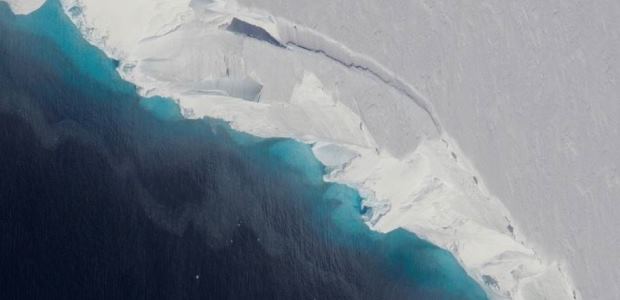
NASA Reports Giant Hole Beneath Thwaites Glacier
The size of a cavity under a glacier plays an important role in melting, said the study's lead author, Pietro Milillo of JPL. "As more heat and water get under the glacier, it melts faster," Milillo explained.
NASA has confirmed that a huge cavity — two-thirds the size of Manhattan and almost 1,000 feet tall — is growing at the bottom of Thwaites Glacier in West Antarctica. This is one of several worrisome discoveries reported in a new NASA-led study of that glacier, with NASA saying the findings "highlight the need for detailed observations of Antarctic glaciers' undersides in calculating how fast global sea levels will rise in response to climate change."
(The photo of the glacier included in this article is credited to NASA/OIB/Jeremy Harbeck.)
Researchers expected to find some gaps between ice and bedrock at the bottom of the glacier where ocean water could flow in and melt the glacier from below. But the size and fast growth rate of the hole surprised them: It's big enough to have contained 14 billion tons of ice, most of which melted during the past three years.
"We have suspected for years that Thwaites was not tightly attached to the bedrock beneath it," said Eric Rignot of the University of California, Irvine, and NASA's Jet Propulsion Laboratory. He is a co-author of the new study, which was published in Science Advances. "Thanks to a new generation of satellites, we can finally see the detail."
The cavity was revealed by ice-penetrating radar in NASA's Operation IceBridge, an airborne campaign beginning in 2010 that studies connections between the polar regions and global climate. The researchers also used data from a constellation of Italian and German spaceborne synthetic aperture radars.
The size of a cavity under a glacier plays an important role in melting, said the study's lead author, Pietro Milillo of JPL. "As more heat and water get under the glacier, it melts faster," Milillo explained.
NASA reported that Thwaites Glacier is currently responsible for approximately 4 percent of global sea level rise. It holds enough ice to raise the world ocean a little over 2 feet (65 centimeters) and backstops neighboring glaciers that would raise sea levels an additional 8 feet (2.4 meters) if all of the ice were lost.